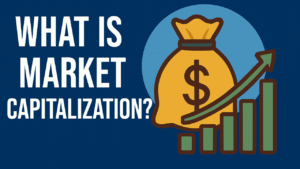 What Is Market Capitalization and Why It Matters?
What Is Market Capitalization and Why It Matters?
If you’ve ever looked at a stock profile or financial news, you’ve likely seen the term “market cap.” It’s one of the most fundamental metrics used to assess a company’s size and plays a big role in how investors evaluate risk and opportunity. But what is market capitalization exactly, and why does it matter for your investments? Let’s break it down.
What Is Market Capitalization?
Market capitalization (or market cap) is the total value of a publicly traded company’s outstanding shares. It reflects how much the company is “worth” in the eyes of the market.
💡 Formula:
Market Cap = Share Price × Total Number of Outstanding Shares
🔍 Example:
If a company has 10 million shares outstanding and each share is worth $50, its market cap is:
$50 × 10 million = $500 million
Why Is Market Cap Important?
Market cap helps investors:
- Understand a company’s size and financial strength
- Compare businesses across different sectors
- Assess risk vs reward in investing
- Choose investments that match their strategy (e.g., growth vs stability)
Unlike stock price alone, which can be misleading, market cap offers a more accurate view of company value.
Types of Market Capitalization
Companies are often grouped by size into the following categories:
1. Large-Cap (Over $10 Billion)
- Established companies with global operations
- Often pay dividends and are seen as stable
- Lower volatility, steady growth
Examples: Apple, Microsoft, Johnson & Johnson
2. Mid-Cap ($2 Billion to $10 Billion)
- Slightly riskier but with more room to grow
- Can offer a balance between growth and stability
Examples: Etsy, Carvana, Roku (subject to market changes)
3. Small-Cap ($250 Million to $2 Billion)
- Younger or niche companies
- Higher risk, but higher potential returns
Examples: Upstart Holdings, Beyond Meat
4. Micro-Cap (Below $250 Million)
- Very small firms, often thinly traded
- High volatility and limited information
How Market Cap Affects Investing Strategy
- Large-cap stocks are ideal for conservative, long-term portfolios.
- Mid-cap stocks offer a middle ground—growth with moderate risk.
- Small-cap stocks may appeal to aggressive investors looking for high upside.
Your risk tolerance and time horizon should help determine your ideal market cap allocation.
Market Cap vs Enterprise Value
Market cap is not the same as a company’s enterprise value (EV), which also considers debt and cash holdings.
| Metric | Includes Debt? | Includes Cash? | Use Case |
|---|---|---|---|
| Market Cap | ❌ | ❌ | Size & popularity |
| Enterprise Value | ✅ | ✅ | Takeover cost & capital structure |
Limitations of Market Cap
- Doesn’t measure intrinsic value or whether a stock is over/undervalued
- Can be skewed by speculation (especially in small/micro-cap stocks)
- Doesn’t reflect debt obligations or cash reserves
That’s why market cap should be used alongside other financial metrics when analyzing a stock.
✅ FAQ: Market Capitalization
1. Is a higher market cap always better?
Not necessarily. A higher market cap means a company is large and possibly more stable, but it doesn’t guarantee faster growth or higher returns.
2. Can market cap change daily?
Yes. Since market cap depends on the share price, it fluctuates as the stock price rises or falls.
3. What’s the difference between stock price and market cap?
Stock price is the cost of a single share. Market cap is the total value of all shares combined. A company can have a high stock price but a small market cap if it has few shares.
4. Do ETFs or index funds use market cap?
Yes. Many funds, like those that track the S&P 500, are market-cap weighted, meaning larger companies have more influence on performance.
5. Can a small-cap company become a large-cap?
Absolutely. Many large companies started small and grew over time. That’s why some investors focus on small-cap stocks—they hope to catch the next big winner early.